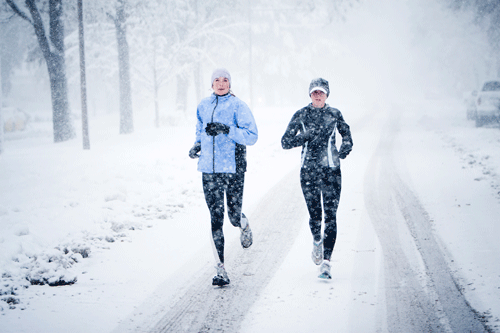Jim is an accomplished triathlete and endurance cyclist, and has raced in more than 35 USAT-certified races. He is also an avid trail runner and endurance gravel bike rider. Jim is a founder of Complete Tri and frequent writer on triathlon and cycling.
Runners who live in colder climates or climates with the possibility of a couple colds snaps a year undoubtedly face a common question: Should I run outside, run inside on a treadmill, or temporarily stop my training until it gets warmer? Being a Minnesota-based organization, we know a thing or two about cold weather running. We hope you choose to run outside, and we are here to help you learn how to embrace the cold and enjoy some cooler workouts.
Any cold weather runner will tell you that running in cold weather can actually be an invigorating experience – the landscape is different, the trails are often quieter, and you can get a respite from hot or muggy summer days that drain your energy. Winter runs are often some of the sunniest days you will find, adding to the energy of a run.
If you need additional reasons to run outside in the cold, don’t forget that you get a nice two-for-one on your metabolic rate — the energy required to keep your core warm is above and beyond what you will expend by running alone.
If you are new to cold weather running, or just want to do it more comfortably, ask yourself a few questions first: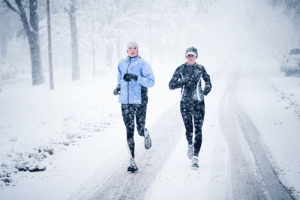
- Do you have the right cold weather running gear? We’ve all heard that active people should wear layers in cold weather, but there is more to it than that.
- Are your extremities protected? Once your extremities get cold, it is hard to stay comfortable because your blood flow is reduced in cold temps.
- Are you only running, or are you biking in winter too? Cold weather cycling clothing overlaps with cold weather running clothing, but there are some differences.
- Are you wearing materials that prevent you from becoming chilled? Different conditions call for different materials – thermals, waterproof, windbreaking, etc.
- Do you have appropriate wind protection? Even on a sunny day, the wind can sometimes make the difference between a chilled core and a warm one. Having the right kind of running jacket makes a huge difference.
- Is your footwear compatible with your running surface? This is less about warmth and more about your safety.
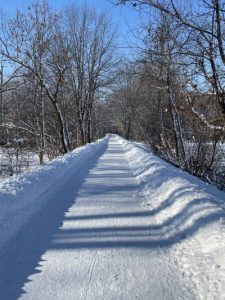
Answering these questions well will significantly increase your comfort in cold weather, not to mention your safety.
COLD RUNNING WEATHER DEFINED
What is the definition of cold weather? For folks in Florida, anything below 55 degrees might be considered cold, or at least cool. If you live in Maine or Michigan, you might consider 20 degrees tolerable if conditions are right, and may even be willing to run outside in below zero temps. And running in snow may require different considerations than simply running on a cold day but a dry surface.
Are you physically able to handle the cold? In most cases, if you are a runner, the answer is an easy yes. But just like some people can’t handle a hot, humid run, others aren’t built for a cold weather run. If you have lungs that are sensitive to cold air, you may want to limit your cold weather runs to 35 degrees or higher. If your knees act up when running in lower temps, you might need to invest in additional leg warming gear, thermal running tights, or use treadmills in extreme cases. Knee warmers shouldn’t be out of the question for people with achy knees.

In most cases, though, you can dress perfectly for a cold weather run with just a little investment and planning.
Cold weather running often has as much to do with the running surface as the air temp. If your favorite trail has a thin layer of ice, or there is a risk of getting splashed by passing-by cars spraying wet rain or slush, then you are definitely in a different mode of running than in the summer.
Cold weather runs can be among the most enjoyable of the entire year. With a little preparation, you’ll be ready to seize that winter day.
RUNNING IN COLD WEATHER: GEAR CONSIDERATIONS
When you bike, swim, or rock climb, you wear the right gear for the activity. The same goes for running in cold weather. From head to toe, making sure you have the workout gear can make the run exponentially more comfortable. Before we describe your various options, let’s outline the different factors involved with cold weather running:
- Temperature. Most people think of cold weather as being low temps. That is part of the equation. We generally start to think about dressing for the elements at temps lower than 55, and go into all out winter gear at about 35 or 40 degrees. However, there is way more to it as you will see in the following points.
- Wind. Wind has a huge effect on cold weather running comfort. A 30 degree day can be very comfortable if there is no wind, but very chilly if you have a moist breeze blowing. In some conditions, frostbite can set in quickly if the wind is just right. Having a lightweight shell available can allow you to throw on wind protection whenever you need it without significantly adding weight or changing your heat level.

Air temperature is just one factor to the cold running equation. Wind also has a major effect. courtesy of National Weather Service. Precipitation. Obviously, precip makes a huge difference on your comfort outside, even in warm temperatures. In many cases, your wind protection layer can double as rain or snow gear, but only to a point. In our opinion, running in cold rain is not worth it. In particular, protect your feet when running in wet conditions – it is a prime condition or introducing blisters, even in warm weather. Snow, on the other hand, is often easier and less dangerous to run in than rain, especially with colder, drier snow, as the flakes will simply slide off of you as you run.

- Sun. The inverse of our precipitation point, if it is a sunny day, you can often get by with a little less thermal coverage than if it is overcast or precipitating, even if the temp is the same. Beware of the long activities when you may start out in the sun but finish in other conditions. Dress for the worst.
- Activity. This article focuses mainly on running, but think about the breadth of your activity. Will it just be a slow jog? If so, layer up because your core temp might not heat up quickly. Will cycling be involved? If so, be sure to cover exposed skin and have some great wind-cutting gear because the speed of the bike acts as a strong wind.
- Traction. Your footing cannot be overlooked when running in cold weather. Icy conditions can persist when temps are below freezing, creating a workout hazard. This can be mitigated by taking short, more sure strides, and by wearing more rugged footwear, but there is no absolute solution for ice. Some of the most annoying conditions are just above the freezing point, especially after snow. Large puddles can form in very inopportune places, and clay or gravel trails can sometimes turn into a sticky muck that can clog your shoe treads. Again, rugged footwear can help but there are some days that you just can’t get around the issue. The good news is that the extra effort required to keep your balance on snow and ice provides work for leg muscles that you wouldn’t normally use on a summer run.
- Visibility. Keep in mind that winter runs are often done in lower light. If you must run near traffic, consider your visibility to drivers. We like some of the basic and inexpensive reflective running gear that is on the market today, as it can help you be seen much better when the sun might not help you be visible.
- History. Don’t ignore your injury history. We once ran with a runner who had a badly compromised hamstring, and running at even 45 degrees could aggravate the injury. This person would wear running tights in anything below 60 degrees. If you have sensitive lungs, don’t be embarrassed to don a balaclava a little earlier than your friends. If your knee acts up in colder weather, consider knee warmers or thermal tights at temps that might be higher than normal. We’d rather have you a little too warm than injured.
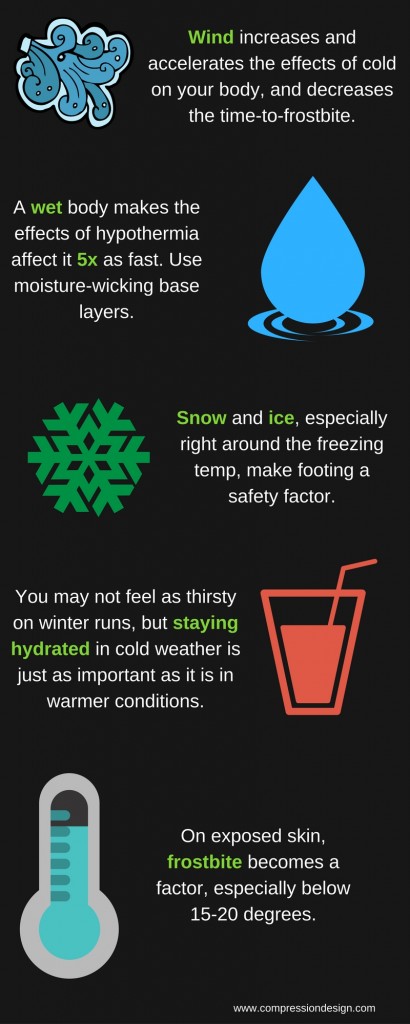
RUNNING IN COLD WEATHER: GEAR OVERVIEW
So you are ready to run outside and have gone through the gear considerations. It is time to select your running gear.
TWO RULES: LAYERS ARE GOOD, AND MOISTURE IS BAD.
Layers are a great way to customize your running outfit to the exact conditions of the day. Remember, this is about function, not form. Do not care how you look – care only about how comfortable you are. A 35 degree day with sun and no wind might simply warrant a medium-weight base layer and nothing else. A blustery 25 degree day might call for that same base layer with an entire wind protection layer on top, and even a few optional pieces like a neck gator or partial mask. Take a page from skiers, who have scalable outfits for nearly every condition. Some of the most relied upon cold weather running outfits are simple two-layer combos: A base layer for warmth, and a shell layer for window or precip protection.
Dressing for the cold isn’t just about comfort, either. The NIH studied cold-weather runners and found hard data to support the fact that your body expends more energy when it is in an environment of cold and wet conditions. If you are expending more energy just to stay warm, that means that you have less energy for your run or activity. Your performance suffers.
Cotton is bad because it holds moisture and has poor insulation qualities. It might feel good against your body when dry, but as soon as you begin to sweat it does two things: Adds to your chill, and gets heavy. Have you ever had a wet cotton shirt on, even on a comfortable summer day? It can quickly get cold, making you clammy. Better options are good, old fashioned wool, which can often absorb 1/3 of its weight in water without feeling wet, or synthetics, which are often specifically designed for sport conditions and can do an incredible job of keeping moisture away.
HIGH-QUALITY COLD WEATHER GEAR
You may often find that you will need to pay more – many times more – for a good synthetic base layer at an outdoor store than for an inferior base layer at a discount store. It is probably worth it. Remember the old rule of: “Junk in – junk out.” You might go through a half dozen cheap base layers in the time that would take to wear out one high quality garment. On the higher quality cold weather gear, the stitching tends to be better, then fabric tougher, the garment holds its shape and color better after many washings, and better fabrics tend to not hold the “stink” that can make itself at home in a cheaper garment after a few uses.
Keeping Yourself Warm: From Head to Toe
The best approach is to avoid going out and buying one coordinated exercise suit like you might have in the 80’s. Instead, evaluate every piece on its own merits and by the best-of-breed for every part of your body. Here are a few tips:
Head
Keeping your head warm on runs is important. While your mother probably had a saying that you lose heat through your head, that isn’t exactly true. But if you have a warm layer over the rest of your body, an exposed head will certainly become highly uncomfortable. A lightweight synthetic hat or “skull-cap” can often be comfortable, and is thin enough to let you wear other gear such as a helmet if you happen to be cycling. Wool hats are also effective but tend to be bulkier. Be sure to cover your ears, not just kind-of but wholly, and in a way that will keep wind from sneaking up through the openings. Finally, think about your running headphones, if you use them, and get something that won’t be so tight around you head that the earbuds or headphones will cause discomfort. Face
Face
If you need face protection, as many do in, say, sub 20 degree or windy days, you have a few options. A full balaclava will cover everything
but your eyes and is right for the most extreme conditions. It is often too much for days that aren’t intensely cold or windy. A partial mask can cover your face but probably not your nose or even your mouth – right for cold days that aren’t as extreme. A simple neck gator can be used to pull up over your chin and mouth if you don’t think you need a mask. Think about how your eye protection will work — if you wear sunglasses to run in winter, make sure they don’t fog with your facial protection system.
You may have also heard about people who put vasoline on their face before a cold-weather run, bike ride, or even ski day. It works. Any petroleum-based jel will create a thin layer of protection, keeping your skin warmer and protecting it a bit from the elements.

Neck
An exposed neck and cause disproportionate discomfort, and also allow wind to get in under your jacket. If you are using a balaclava, you are covered. Otherwise, you will need to think about other options. A neck gator, like those used in skiing, can often be a useful garment for both your neck and your lower face. Otherwise, try to either get a turtleneck-styled base layer, or an outer layer that has a collar that zips up to your chin.
Torso
This is where you have many options, but you will typically want a synthetic long-sleeved base layer, an optional heavier-weight warmth layer made of wool or synthetics, and an optional shell layer that can protect you from wind or light precipitation. The outer layer — a running jacket — can either come in the form of a thermal jacket, or simply in a shell that is designed to keep you dry. Note that “water-resistant” does not always mean “waterproof” (the latter will cost more). Sometimes two of these layers come in the same garment. This is alright, as one of our favorite torso garments is a medium-weight warmth layer that has a light coating to it for light wind. But going the combo route will probably result in more overall pieces in your closet, so be sure to buy according to your common conditions. You can also use a moisture-wicking compression top as the base layer against your skin, with another layer on top of it depending on the specific conditions of the day. Old fashioned sweatshirts are sometimes OK for a warmth layer, but they are often made of cotton so are ineffective and even a liability once they get wet. A good rule of thumb is to always use something that will keep bad stuff from getting on you (moisture, wind) and keep you just warm enough to be comfortable (thermal qualities). The best gear answer might be different on two 25-degree days, one that is still and sunny and another that is windy and snowy.
optional shell layer that can protect you from wind or light precipitation. The outer layer — a running jacket — can either come in the form of a thermal jacket, or simply in a shell that is designed to keep you dry. Note that “water-resistant” does not always mean “waterproof” (the latter will cost more). Sometimes two of these layers come in the same garment. This is alright, as one of our favorite torso garments is a medium-weight warmth layer that has a light coating to it for light wind. But going the combo route will probably result in more overall pieces in your closet, so be sure to buy according to your common conditions. You can also use a moisture-wicking compression top as the base layer against your skin, with another layer on top of it depending on the specific conditions of the day. Old fashioned sweatshirts are sometimes OK for a warmth layer, but they are often made of cotton so are ineffective and even a liability once they get wet. A good rule of thumb is to always use something that will keep bad stuff from getting on you (moisture, wind) and keep you just warm enough to be comfortable (thermal qualities). The best gear answer might be different on two 25-degree days, one that is still and sunny and another that is windy and snowy.
Hands
The number one reason to turn back for different clothing a minute in to a cold weather run or winter fat bike ride? My hands.
Don’t overlook the need to keep your hands warm, dry, and protected from wind. A good pair of running gloves will be lightweight, wind-resistant, warm, and have some level of water resistance. Today’s running gloves also give you features like touchscreen-compatible fingertips, reflectivity, and and soft pads for wiping a runny nose. We go into significant depth on the gloves topic in our winter running gloves article. If you are a cyclist, double-down on your gloves investment, as those hands will be breaking the wind for the rest of your body. Consider something with strong windbreaking properties.

Underwear and Base Layers
But don’t I just wear my underwear, you might ask? Well, only kind of. If you haven’t discovered synthetic underwear designed for active people, buy some. They are a big improvement over the pieces you would typically wear under regular clothing. Again, the key is making sure that whatever is touching your skin can stay dry. Our favorite choices for a good cold weather base layer are a good pair of compression shorts underwear from any number of makers, or the Ex-Officio Give-N-Go, a simple but all-purpose synthetic brief. As for the rest of your base layer, make sure anything touching your skin is moisture-wicking, or wool. Both will make sure that you don’t have damp, wet fabric touching your skin, something that negates the thermal benefits of your other clothing. We especially like synthetics and merino wool. Merino wool is softer and itches less because it is a finer fabric overall.
Legs
You have a multitude of options for your legs in cold weather running. If you run in low temps, the key is to look for the word “thermal”. These models give you extra heat-retaining qualities, but in a way that doesn’t make you retain moisture in the clothing. Some of the best overall leg garments we know of were actually developed by the bike industry – they provide enough warmth for comfort but also have enough of a light outer coating to stop wind. Other options include old-fashioned running tights, either alone or under an outer layer, or wool leggings. Wool leggings can be nice because they often come in different weights, so can be purchased according to your common conditions. Old-fashioned sweatpants are no longer best-of-breed because they are so much bulkier and heavier than products that have been developed over the past decade, and really aren’t comfortable compared to more advanced garments. Plus they are miserable if they get wet. The trend is definitely toward more synthetic (because they wick moisture) and form-fitting (because they don’t allow a breeze against your skin) winter running and cycling apparel.We did an entire project analyzing the best thermal running tights on the market — feel free to use it as your reference. We try our best to suggest some of the running and cycling bottoms that might work for a variety of budgets.
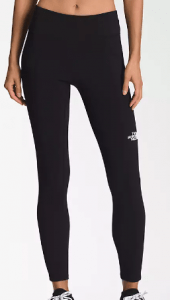
Socks
Don’t forget about socks in cold weather, as the right sock can keep your foot warm enough so you can wear your normal running shoe – always a good thing. Be sure to buy sock that go above your ankle, so your leg wear and sock and overlap, reducing any exposed skin. Some of the best socks in the market are made for outdoor hiking by brands such as LL Bean or Filson. They often come in low, medium, and heavy weights, and we can attest that the heavy weight socks are often too hot even for cold conditions. A good pair of medium-weight socks from any outdoor gear manufacturer will usually feel great down to relatively low temps. You might also consider compression socks which often rise as far as the knee, and can minimize the chances of any exposes skin around the ankle. Remember, a too-bulky sock might fit tightly in your shoe, creating an odd fit or even sore feet during the run.
Shoes
Many shoes have hit the market that are branded as cross country or rugged footwear, intended for running and other activities. If you plan to run on unstable surfaces or paths that tend to be icy, you may want to consider such products. One of the advancements we’ve seen in the past year or two has been Vibram’s ice-gripping sole. It is worth a look if you expect to be running on slick ice regularly, and comes as a component of several brand-name shoes. For most runners, however, your normal running shoe with a good, warm sock underneath will be fine on dry trails, even if the mercury drops.
Of course, personal preference also comes in to play in a big way. Some people prefer to stay a little warmer on runs, others like to let their core temp warm them up. Some prefer layers, while others like to know they just have a few warm pieces on. Don’t forget about your other gear, such as good water bottles (you lose hydration even on a cold winter day) and other things you might not think about at first.
If you are new to running, and this is all a bit foreign to you, don’t worry. Everyone has to start running sometime. In fact, we did an entire piece on how to start running, something that is an entry-level article for those thinking about picking up the hobby. If you are an experienced runner, good for you. Keep it up.
When it comes to cold weather running, try different things, get to know what you like, and then use it. Just stay comfortable, and your winter runs will end up being some of your best runs of the year.
Sources:
National Weather Service Windchill Chart: https://www.weather.gov/safety/cold-wind-chill-chart
WebMD: Do We Really Lose Heat Through Our Heads?: https://www.webmd.com/a-to-z-guides/features/do-we-really-lose-most-of-our-heat-through-our-heads
